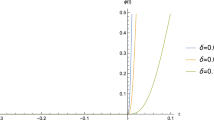Abstract
This paper suggests a new method for solving the cost to go with time penalization. We consider the Lagrange approach in order to incorporate the restrictions of the problem and to solve the convex structured minimization problems. The solution is based on an improved version of the proximal method in which the regularization term that asymptotically disappear involves a penalization time parameter. By assuming that the set of equilibria is non-empty, we show that the proximal algorithm involving time penalization generates a sequence that converges to a saddle point of the Lagrange functional. This method improves the traditional approach of proximal algorithms and its applications. Our approach is implemented using continuous-time Markov chains. We analyze a queueing model with applications to waiting time of customers in the branch of a bank, for showing the effectiveness of the method.

Similar content being viewed by others
Explore related subjects
Discover the latest articles, news and stories from top researchers in related subjects.References
Antipin AS (2005) An extraproximal method for solving equilibrium programming problems and games. Comput Math Math Phys 45(11):1893–1914
Attouch H, Soubeyran A (2011) Local search proximal algorithms as decision dynamics with costs to move. Set Valued Anal 19:157–177
Bao TQ, Mordukhovich BS, Soubeyran A (2015) Variational analysis in psychological modeling. J Optim Theory Appl 164(1):290–315
Bhat UN (2015) An introduction to queueing theory: modeling and analysis in applications, 2nd edn. Birkhäuser, Basel
Carrillo L, Escobar J, Clempner JB, Poznyak AS (2016) Solving optimization problems in chemical reactions using continuous-time Markov chains. J Math Chem 54:1233–1254
Cascone A, Rarita L, Trapel E (2014) Simulation and analysis of a bank’s multi-server queueing system. J Math Sci 196(1):23–29
Clempner JB (2020) Penalizing passenger’s transfer time in computing airlines revenue. Omega 97:102099
Clempner JB, Poznyak AS (2014) Simple computing of the customer lifetime value: A fixed local-optimal policy approach. J Syst Sci Syst Eng 23(4):439–459
Clempner JB, Poznyak AS (2018a) A Tikhonov regularization parameter approach for solving Lagrange constrained optimization problems. Eng Optim. https://doi.org/10.1080/0305215X.2017.1418866, to be published
Clempner JB, Poznyak AS (2018b) A Tikhonov regularized penalty function approach for solving polylinear programming problems. J Comput Appl Math 328:267–286
Garcia CB, Zangwill WI (1981) Pathways to solutions, fixed points and equilibria. Prentice-Hall, Englewood Cliffs
Ge Z, Han D, Ni Q, Wang D (2018) An operator splitting method for monotone variational inequalities with a new perturbation strategy. Optim Lett 12(1):103–122
Guo X, Hernández-Lerma O (2009) Continuous-time Markov decision processes: theory and applications. Springer, Berlin
Lemaire B (1989) The proximal algorithm. Internat Ser Numer Math 87:73–87
Martinet B (1970) Breve communication. regularisation d’inequations variationnelles par approximations successives. Esaim Math Model Numer Anal 4(3):154–158
Moreno FG, Oliveira PR, Soubeyran A (2011) A proximal algorithm with quasidistance. application to habit’s formation. Optimization 61:1383–1403
Poznyak AS, Najim K, Gomez-Ramirez E (2000) Self-learning control of finite Markov chains. Marcel Dekker Inc, New York
Rockafellar R (1976) Monotone operators and the proximal point algorithm. SIAM J Control Optim 14(5):877–898
Tikhonov AN, Arsenin VY (1977) Solution of Ill-posed problems. Winston & Sons, Washington
Trejo KK, Clempner JB, Poznyak AS (2019) A proximal constrained optimization approach with time penalization. Eng Optim 51(7):1207–1228
Yin G, Zhang Q (1998) Continuous-time Markov chains and applications: a singular perturbations approach. Springer-Verlag, New York
Zangwill WI (1969) Nonlinear programming: a unified approach. Prentice-Halt, Englewood Cliffs
Author information
Authors and Affiliations
Corresponding author
Ethics declarations
Conflict of interest
The authors declare that they have no conflict of interest.
Ethical approval
This article does not contain any studies with human participants or animals performed by any of the authors.
Additional information
Publisher's Note
Springer Nature remains neutral with regard to jurisdictional claims in published maps and institutional affiliations.
Rights and permissions
About this article
Cite this article
Clempner, J.B. Solving the cost to go with time penalization using the Lagrange optimization approach. Soft Comput 25, 4191–4199 (2021). https://doi.org/10.1007/s00500-020-05556-6
Published:
Issue Date:
DOI: https://doi.org/10.1007/s00500-020-05556-6




